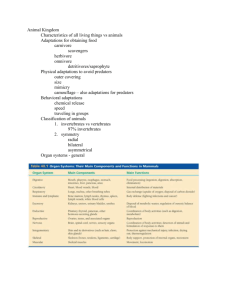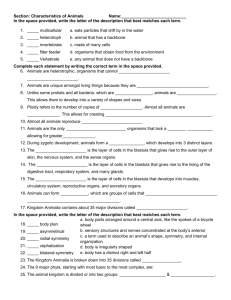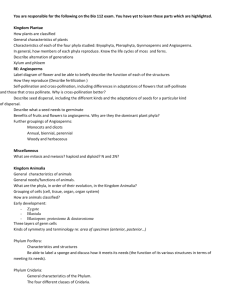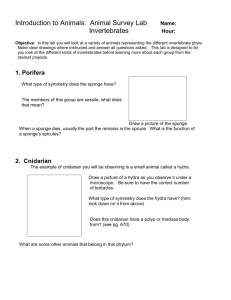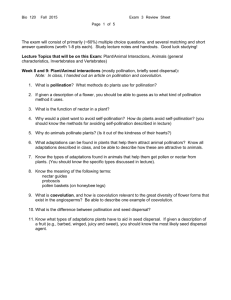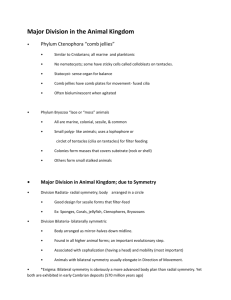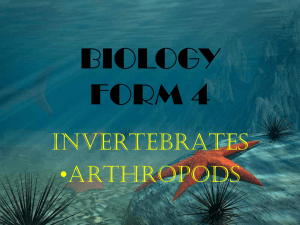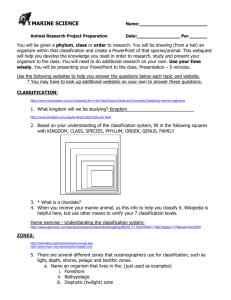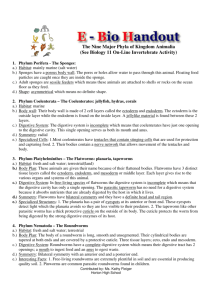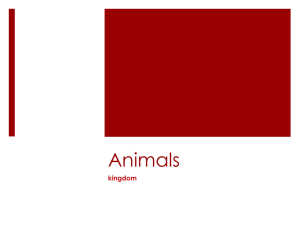Animal Kingdom Characteristics of all living things vs animals
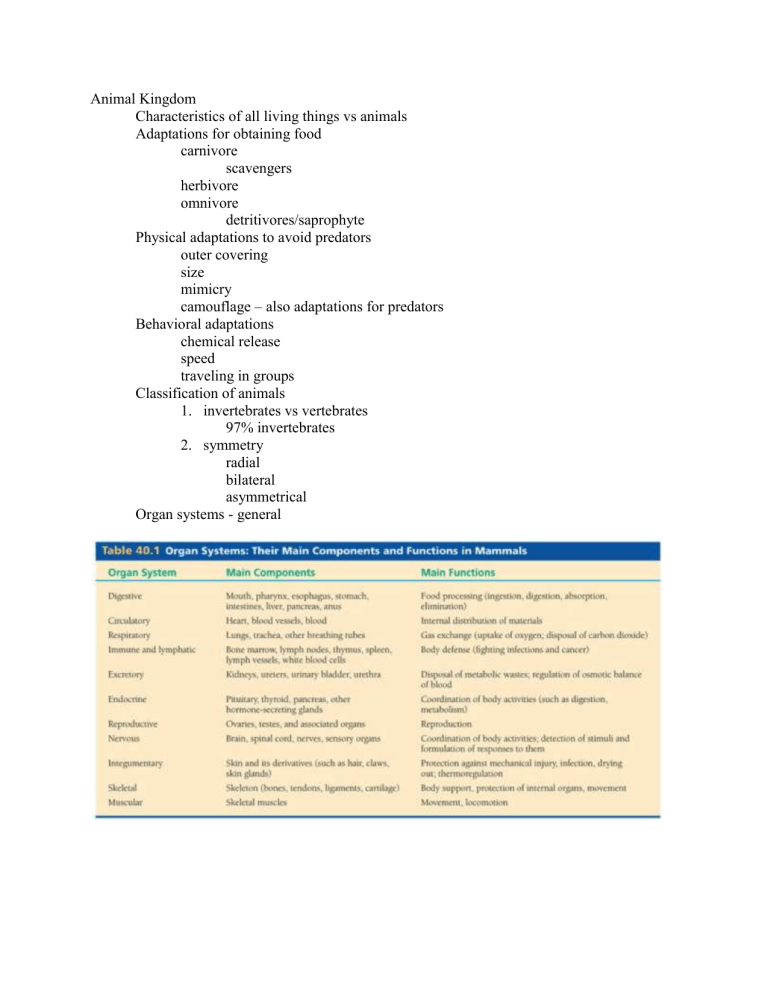
Animal Kingdom
Characteristics of all living things vs animals
Adaptations for obtaining food carnivore scavengers herbivore omnivore detritivores/saprophyte
Physical adaptations to avoid predators outer covering size mimicry camouflage – also adaptations for predators
Behavioral adaptations chemical release speed traveling in groups
Classification of animals
1.
invertebrates vs vertebrates
97% invertebrates
2.
symmetry radial bilateral asymmetrical
Organ systems - general
Phylum Porifera sponges simplest animals eukaryotic loose arrangement of cells – no tissues asymmetrical sessile multicellular filter-feed on plankton ostia = tiny pores leading to channels throughout body of sponge osculum = large opening at top of sponge choanocyte = collar cells (line channels)
2 purposes:
1.
create a current into sponge with their flagella
2.
trap food particles on sticky collar amoebocytes = cells that move food around to other cells within the body spicules – silica structures produced to give shape to organism unique to each sponge reproduction asexual = mitosis sexual sponge:
Phylum Cnidaria – includes sea anemones. hydras, jellyfish, and corals
2 body forms: polyp – vase-like; sessile medusa – bell-shaped; free swimming radial symmetry
2 tissue layers – evolutionary step muscles nerves digestive cavity with one opening food in & waste out tentacles have nematocysts = stinging cells barbs are unique to each species reproduction asexual sexual
Nematocysts = stinging cells of cnidarians earlier generations
Corals: reefs are built as one generation of corals secretes their hard skeletons on those of
Important to ocean ecosystems: provide shelter to diversity of ocean animals provide shelter to economically valuable species – oysters, shellfish,… provide protection for beaches and shorelines from wave action used in medical research – bioprospecting provide clues to locations of geological value – oil bioindicators of the oceans – sensitive to changes in environment
Phylum Platyhelminthes – flatworms and roundworms bilateral symmetry three tissue layers
primitive organs/organ systems digestive circulatory muscular nervous
Flatworms
A.
Planaria – free swimming/living eyespot one opening (mouth & anus) freshwater organism cilia for movement herbivore asexual reproduction – split in half & regenerate sexual reproduction = hermaphrodite planaria
B.
Flukes - parasitic marine flatworm require more than one host small reproduce sexually causes Schistomiasis blood disorder spread by contact with water that contains the parasites occurs in underdeveloped countries potentially fatal to humans from liver, kidney or bladder failures or cancers
fluke
C.
Tapeworms – parasitic complex life cycle bladder worm stage as adult: releases segments, each with fertilized eggs absorbs food from its host
Roundworms or Nematodes common to all environments free swimming/living
2 body openings – first group to have true digestive system reproduce sexually can be beneficial – destroy pests and improve soil conditions can be harmful – disease-causing agent
Phyllum Mollusca second largest phylum fresh & salt water environments land environments too bilateral symmetry soft body enclosed by mantle which may secrete outer shell body cavity between body and mantle = coelom body cavity contains gills – adaptation for oxygen absorption or filter feeding open circulatory system – heart pumps blood to open spaces and to organs well developed head & sensory organs
classified by type of shell and muscular foot ( -pod)
Class Gastropoda ( stomach – foot) snails & slugs tentacles with eyes tongue with radula foot secretes mucus to reduce friction live in moist environments for mucus
Class Bivalvia (hinged shells) clams, oysters, & scallops siphon – special tube used for movement and burrowing expels water forcibly
Class Cephalopoda ( head – foot) octopus, squid most complex well developed nervous system first closed circulatory system foot divided into tentacles with suction cups adaptations for swimming streamlined siphon ink
Value of Mollusks food for fish, humans income decoration shelter for other organisms bioindicators
Harmful Effects damage plants – slugs, snails & property host of parasites – snails
Phylum Annelida – segmented worms
Earthworms, leeches bilateral symmetry coelom with organs found in all moist environments setae = bristle like structures on outside of each segment for locomotion digestive system organisms swallow soil, absorb nutrients from soil, excrete waste waste = castings; important – natural fertilizer closed circulatory system aortic arches with arteries and veins
respiratory system gas exchange through the skin nervous system small brain with nerve in each segment of body negative phototaxic – moves away from light reproduction
hermaphrodite = both male and female organs in organism leeches no setae use suckers to attach to other organisms use anesthetic to numb organism as they latch on cut organism for blood used in medicine marine worms holistic chemicals dialate blood vessels burrow in ocean floor or structures free swimming
mounds made by marine roundworms value of annelids aerate soil by constant burrowing return nutrients to soil leeches in medicine
Phylum Arthropoda – “jointed feet” segmented bodies with exoskeleton bilateral symmetry two body openings open circulatory system nervous sytem adapted to every environment
Class Insecta – largest class on Earth only invertebrates that can fly three body segments – head; thorax; abdomen head = antennae; compound eyes; mouth thorax = legs & wings abdomen = reproductive structures body systems: circulatory; respiratory; excretory; digestive blood contains hemoglobin as in humans respiration through spiracles = openings to the outside through exoskeleton
3 pairs of legs = 3 x 2 = 6 legs metamorphosis = series of changes in body form
2 types: incomplete = egg, nymph, adult complete = egg, larvae, pupa, adult
Class Chilopoda = “many feet” centipedes & millipedes hunt for prey or eat decayed material (saprophyte) millipede – 2 sets of legs (4) per segment centipede – 1 set of legs per segment
Class Arachnida = spiders; scorpions; ticks
2 body segments cephalothorax & abdomen
4 pairs of legs = 4 x 2 = 8 legs adapted with venom glands to paralyze prey; can be deadly (brown recluse) ticks = parasitic adaptations for digestion enzymes that are injected into prey respiration through book lungs – see below (looks like stack of books)
Brown Recluse
Class Crustracea = crabs, lobsters, shrimp
1 or 2 pairs of antennae
5 pairs of legs first pair for catching prey rest for motion
5 pairs of swimmerets – for movement & reproduction exoskeleton (not a shell)
Value of arthropods part of food chains help agriculture with pollination some agricultural products – honey some medicinal advantages bee’s sting/venom is used to treat arthritis
Harmful effects destroy property, food, & clothing locust, insects on crops, moths
Phylum Echinoderma – sea stars, sea urchins, sand dollars, sea cucumbers mostly oceans spiny epidermis radial symmetry with some bilateral symmetry do not have head or brain nervous system digestive system with mouth(underside) unique to this group -water vascular system network of water-filled canals with thousands of tube feet that end in suction cups controlled by changes in water pressure within the system helps them to move, capture prey, exchange gases
Sea stars at least 5 arms can regenerate for repair
Sea urchins globe-shaped covered with spines(ends have toxins)
Sea urchin
Sand dollars
5 pointed pattern on surface covered in silk/hair-like spines
Sea cucumbers body – leathery covering rows of tube feet detritivore/saprophyte when threatened - they expel internal organs; regenerate later
Brittle Stars fragile, slender arms with spines for protection
Value of echinoderms saprophyte and recycle matter some are used in medicine control populations of the sea sea urchin – gourmet delicacy
Closest to vertebrates embryos develop much like vertebrate embryos do
